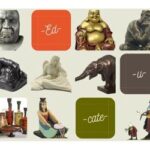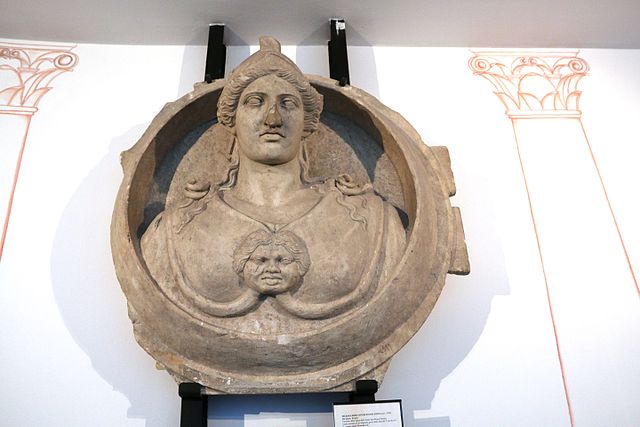Some of the most famous ancient Greek and Roman wall art survive as wall hangings in museums. The ancient classical civilizations created wall paintings, mosaics from glass and semi-precious stone and carved marble raised reliefs.
Here are is a comparison of materials used in ancient wall art: fresco wall painting in vibrant hues called fresco (paint applied to either dry or wet plaster); mosaic tiles called tesserae which are clipped glass fragments in many colors to create a painted look out of glass; carved wall relief which is an image carved into a background to project off the surface.




Through the years Talaria Enterprises has been introduced to a wide selection of Greek and Roman art either as originals in museums or as replicas from our suppliers. Here are some of our favorites.
Greek Warrior Stele – Hang this refined and dignified homage to this Greek Warrior. The Greeks have a long standing tradition of making reliefs or statues in tribute to their fallen warriors as grave site markers. During the Classical era, the warrior is typically identified by his idealized body form and helmet or sword.
Laurel Wreath Ancient Victory Symbol – The laurel wreath has been given to great scholars, artists, soldiers, Roman emperors and victorious athletes, since the times of Ancient Greeks. Its use originated with the Pythian Games, a Panhellenic festival in honor of Apollo.



Nike Relief Greek Goddess of Victory from Acropolis – This relief illustrates the Goddess Nike from the Temple of Athena Nike, Acropolis, Athens, c. 410 BC (High Classical Period). Now housed in the Parthenon Museum in Athens, she is the illustrious Goddess of Victory who guided many Greek warriors to victory in their battles with the Trojans and Spartans. She was well-respected and frequently depicted on reliefs, pottery, and as sculptures. The artist Phidias (500-432 BC) created this relief as well as much of the sculpture and statuary from the Acropolis.
Julius Caesar was a brilliant general and statesman who had a profound impact on history. Between 58 and 50 B.C. he conquered the Gauls in northern Europe, greatly adding to the size and influence of the Roman empire. Following a civil war, he became Rome’s dictator and enacted many needed reforms which helped ensure the success of Rome for centuries to come.


Hippocratic Oath – The Doctor’s Oath here is shown as a writing on papyrus, but is sometimes reproduced as a wall carving as well. Hippocrates (460-377 B.C.) was a Greek Physician who is called the Father of Medicine. His work on epidemics, public health, and the importance of diet in treatment of disease was used in teaching medicine for centuries. He is best remembered as the reputed author of the Hippocratic Oath, that still remains today as the basis of the medical code of ethics. It embodies the duties and obligations expected of those who wish to enter the practice of medicine.
Themis relief, Greek Goddess of Justice – Themis was the Titan goddess of divine law and order – the traditional rules of conduct first established by the Greek gods. She was also a prophetic goddess who presided over the most ancient of the earthly oracles, including the shrine of Delphi. In this role, she was the divine voice who first instructed mankind in the primal laws of justice and morality, such as the precepts of piety, the rules of hospitality, good governance, conduct of assembly, and pious offerings to the gods. In Greek, the word themis meant divine law, rules established by custom and tradition. Unlike the word nomos, the term was never used to describe laws established by human decree. Themis was an early bride of Zeus and his prime counsellor. She was often represented seated beside his throne advising him on the precepts of divine law and the rules of fate. Themis was closely identified with Demeter in her role as the Thesmophoros (Law Bringer). Themis was also identified with Gaia (Earth) especially in the role of earthly oracle of the prophetic voice of earth itself.
Greek Wrestlers Relief – In ancient Greece, wrestling occupied a prominent place in legend and literature; wrestling competition, brutal in many aspects, was the supreme contest of the Olympic Games. The ancient Romans borrowed heavily from Greek wrestling, but eliminated much of its brutality. Wrestling to the Greeks was not only part of a soldier’s training regimen, but also a part of everyday life. Youth did not only learn grammar, rhetoric, and mathematics, but young men also went through physical training which consisted of dancing and the art of wrestling. Boys were paired up and learned the art of wrestling in their master’s palaestra, or private exercise court built onto the house of a schoolmaster, under the supervision of their instructor. The Greek recognized wrestling as a means of development of grace and symmetry in a vigorous activity that demands a high degree of skill and physical fitness. In ancient times, the awards were not medals but a sacred olive tree wreath. The competition was open to all Greek men who were not slaves. They could also be of any social status.



Labors of Hercules and the Nemean Lion – Hercules wearing the Nemean lion skin after defeating him is here shown as vase illustration, but is sometimes reproduced as a wall carving or sculpture as well. Hercules was the son of Zeus, the Greek God, and Alcmene, a mortal woman, making Hercules half human/ half god. Hera, Zeus’s wife was not pleased that Zeus had cheated on her with a mortal woman, so at every chance, she would try to kill or drive Hercules insane. In doing so, Hercules was forced to perform 12 labors for Eurystheus, the king of Tiryns and Mycenae. The first of his twelve labors involved him bringing back the skin of a ferocious lion named the Nemean Lion. Hercules tracked down the beast and cornered it in a cave. Shown on this wall hanging is Hercules struggling with the beast.
Oedipus and the Sphinx – The Sphinx terrorized the Greek inhabitants of the city Thebes. The Sphinx would destroy anyone who would not answer it’s riddles. Oedipus one day on his travels meets the Sphinx and is asked, “Which animal has one voice, but two, three or four feet being slowest on three?” Oedipus answers correctly, by saying, “Man”.
Three Graces Attendants of Aphrodite – As constant attendants of Aphrodite (Venus), the Three Graces are young, beautiful, modest personifications of gracefulness. This wall hanging is reproduced at the exact size of the original in the Louvre, Paris.




Athena Minerva Greek Roman Goddess – The Greeks built the Parthenon for her, but she is ready to guard your sacred domicile. Athena–as goddess of wisdom, skills and warfare–was one of the twelve Olympians who assembled on Olympus with their own society, laws, and hierarchy. Here in this relief fragment (c. 450-420 BC) from the Parthenon in Athens, she is depicted wearing her traditional helmet and wearing the face of medusa on her chest. The wall carving is a tondo, with the artist’s subject carved in a round form and appearing to pop out of the circle.

Our Greek and Roman Wall Art Collection is always increasing as it is a particular favorite of our curator! Our collection reproduces portions of these famous wall hangings suitable for home and garden decor.
Many of these wall hangings are not mass produced and will require 2- 6 weeks for production.





